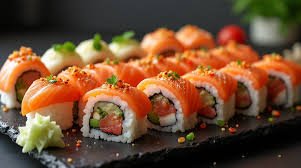There’s something quietly intimate about ordering sushi. You’re not just picking a dish; you’re stepping into a centuries-old story — one written in the language of rice, fish, and the silent nods of a chef behind the counter. The moment the plate arrives — perhaps with a glistening piece of salmon resting atop a small pillow of vinegared rice — it’s more than a meal. It’s an inheritance.
I still remember the first time I had salmon sushi. The memory has edges softened by time, but I recall the hum of conversation in the room, the steady rhythm of knives against wood, and the warm, almost sweet scent of freshly cooked rice. It felt like the plate in front of me had traveled further than I ever had — a bridge between oceans, generations, and traditions.
And in a way, that’s exactly what sushi is: a conversation between the past and the present.
Salmon’s Journey into the Sushi World
Contrary to what many people assume, salmon sushi isn’t an ancient Japanese tradition. For much of Japan’s history, salmon was eaten cooked or cured — never raw. The reason was simple: local salmon often carried parasites, making it unsafe for raw consumption.
The shift began in the late 20th century, thanks to an unexpected partnership between Japan and Norway. In the 1980s, Norwegian salmon producers approached Japanese markets with a pitch that seemed audacious at the time: use Norwegian farmed salmon for sushi. This salmon was parasite-free, raised in cold, clean waters, and perfect for raw preparation.
At first, Japanese consumers were skeptical. Raw salmon was unfamiliar — even unthinkable — in sushi form. But slowly, through marketing campaigns and the gentle persuasion of sushi chefs, it caught on. Today, salmon nigiri is one of the most popular sushi choices worldwide.
This story isn’t just about taste. It’s about how culinary traditions bend and evolve without breaking. It’s a reminder that even the most timeless dishes have a point of origin — a moment when they were new, and perhaps even strange.
The Ritual of the Order
Ordering sushi, especially something as specific as a sushi order topped with salmon, is a little ritual in itself. There’s an unspoken etiquette — knowing whether to call out the order directly to the chef, whether to let the server handle it, how to eat it without drowning it in soy sauce.
If you’ve ever read this deeper dive on sushi etiquette and tradition, you know that a single bite of sushi can carry layers of cultural meaning. In traditional settings, the chef is not just making your food; they’re curating your experience — adjusting temperature, texture, and flavor balance in real time.
When that salmon nigiri arrives, it’s been placed before you at its peak. The rice is still warm from the chef’s hands; the salmon is cool and supple, its surface catching the light. If you close your eyes, you can taste the story before you even bite down.
Why Salmon Holds a Special Place
There’s a reason salmon continues to stand out among sushi options. Its flavor is rich yet clean, with a buttery texture that appeals to both beginners and seasoned sushi lovers. Unlike leaner fish like tuna or snapper, salmon has a natural fattiness that pairs beautifully with the slight sweetness of sushi rice.
For many people trying sushi for the first time, salmon is the gateway. It’s familiar enough not to intimidate, yet special enough to feel like a departure from everyday meals. In sushi bars around the world, it’s often the first nigiri ordered and the last piece savored before the bill arrives.
Craftsmanship at the Counter
A sushi chef’s relationship with salmon is a masterclass in precision. It begins with the selection — the fish must be fresh, firm, and richly colored. Then comes the slicing: a single, fluid motion that preserves the flesh’s integrity. The cut is angled to maximize the texture and visual appeal.
The rice, too, is a labor of love. Perfect sushi rice is neither sticky nor loose, seasoned with just enough vinegar to complement, not overpower, the fish. The chef’s hands move quickly but gently, forming a shape that will hold together yet dissolve easily in your mouth.
The result? A single bite that is deceptively simple but impossibly refined.
The Cultural Layer Beneath the Bite
Eating sushi topped with salmon is also a window into cultural fusion. While purists may cling to traditional white fish and tuna, salmon’s acceptance reflects a broader truth: food cultures are never static. They evolve through trade, migration, curiosity, and necessity.
In Japan, salmon sushi has become so normalized that younger generations sometimes assume it has always been part of the cuisine. Meanwhile, in the West, it often represents the pinnacle of freshness and indulgence — the piece you save for last.
Every order is a small act of participation in that global exchange.
A Personal Reflection
I’ve often thought about how food is a form of storytelling. You might not know the fisherman’s name, the farmer’s struggles, or the chef’s training, but you taste the echoes of all of them.
When I order salmon sushi, I’m reminded of how traditions can adapt without losing their soul. I’m reminded that somewhere, decades ago, someone took a risk — offering raw salmon to a skeptical audience — and changed the course of sushi history.
In that sense, a sushi order topped with salmon isn’t just lunch or dinner. It’s proof that openness to something new can create beauty we didn’t know we were missing.
See More: Mistyinfo.blog
Table: Salmon Sushi in Context
| Aspect | Traditional Sushi (Pre-1980s) | Modern Sushi with Salmon |
|---|---|---|
| Common Raw Fish | Tuna, snapper, mackerel | Salmon, tuna, yellowtail |
| Preparation Style | Focus on local, seasonal fish | Global sourcing, fusion influences |
| Cultural Perception | Salmon eaten cooked or cured | Salmon embraced as premium raw fish |
| Popularity Worldwide | Limited to traditional varieties | Salmon among top 3 sushi choices |
FAQ – The Story and Taste of Salmon Sushi
1. Is salmon sushi traditional in Japan?
No — it became popular in Japan only in the late 20th century, after Norwegian salmon was introduced for raw consumption.
2. Why was raw salmon not eaten in Japan historically?
Local salmon often carried parasites, making it unsafe unless cooked or cured.
3. What makes salmon sushi so popular worldwide?
Its rich, buttery texture and clean taste appeal to both beginners and experienced sushi lovers.
4. How should you eat salmon nigiri properly?
Traditionally, you turn it slightly to dip the fish (not the rice) in soy sauce to maintain balance.
5. Is farmed salmon safe for sushi?
Yes, when sourced from reputable suppliers, farmed salmon is parasite-free and sushi-grade.
6. Does the chef prepare salmon differently from other fish?
Yes — salmon is often sliced at a specific angle to highlight its marbling and texture.
7. Can you find salmon sushi outside Japan?
Absolutely — it’s one of the most widely available sushi options globally.
8. What drink pairs best with salmon sushi?
Light sake, green tea, or even a crisp white wine complements its richness.
9. Why does sushi feel different when ordered directly from the chef?
It’s served at the perfect moment, with balance and temperature in mind — a level of detail that elevates the experience.






